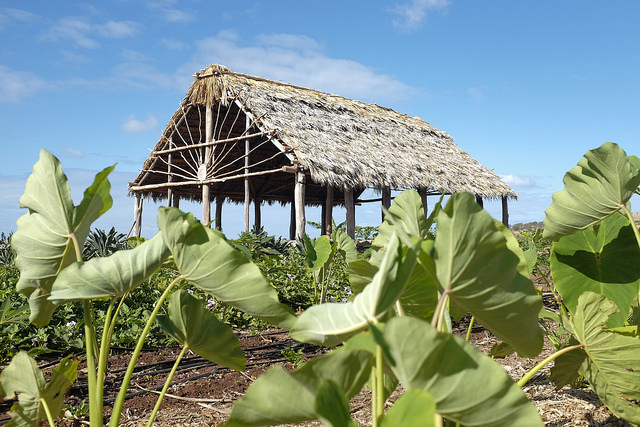Students at the University of Hawaiʻi at West Oʻahu will soon be at the forefront of what some are calling the green collar economy. But first, they will need to break a sweat and get dirty.
“The UH West Oʻahu garden is designed as a living laboratory,” explains Assistant Professor of Sustainable Community Food Systems Albie Miles. “We teach the theoretical elements of ecological sustainability and agriculture and we use the garden as a site for hands-on learning where we’re integrating the theory with the practice.”
The bachelor of applied science in sustainable community food systems is a multidisciplinary program combining sustainability, environmental science, agriculture and the politics of food, developed in close partnership with Kamehameha Schools and MAʻO Organic Farms.
“We’re getting to meet community leaders and people who are affecting change in the food system and getting to understand the work that they do,” says early program enrollee Silvan Shawe of meeting people like Kamuela Enos, director of social enterprise at MAʻO Organic Farms.
“This becomes a space where Professor Albie Miles talks about ‘a meeting of wisdom,’ where the practices of ancestry are repurposed for a contemporary context,” says Enos.
“We’re attempting to train a new generation of people to think critically and systemically about the food system,” adds Miles. “How it functions—ecologically, socially, economically—and how and what ways might that food system be changed to increase it’s ecological sustainability and social equity.”
Enos thinks the program will appeal to students like those MAʻO works with on the Waiʻanae coast, many of whom are Native Hawaiian.
“You can go for a higher education diploma without seeing your role after that as just sitting in an office,” he says. “You can be true to this idea of working with your hands, working with the land, while having a really quality education that allows you choice and control in your life.”
On the east side of Oʻahu in the agriculturally rich Waiāhole Valley, agroecology students are learning how different kinds of food production systems perform environmentally.
“We have a lot of environmental issues that have been caused from conventional agriculture practices like pesticide use, and just the methods that they use, wasting water, stuff like that,” says student Carly Wilson.
“Right now things aren’t exactly sustainable, we’re degrading certain qualities of our ecosystem,” agrees fellow student John Canner.
“Now we’re just doing some weeding,” says Wilson, explaining the work that has them outside instead of the usual classroom. “When you don’t use pesticides and herbicides, weeds build up, so you have to use human labor instead.”
“We’re not actually throwing away the weeds,” Canner adds. “We’re just using them for compost. More nutrients for the actual taro.”
While the labor is hard, the payoff of having a workforce highly skilled—like the Hawaiians of old—in sustainable food production, will be environmentally beneficial, even potentially life-saving.
Importing an estimated 90 percent of food, fertilizer, energy and seed, the Hawaiian Islands are uniquely vulnerable to statewide food insecurity in the face of rapid global climate change or economic disturbances.
“Our aim is to train a new generation of food system professionals,” the professor explains. “To think across traditional disciplinary boundaries and to actively solve current problems through work in agriculture, policy-making, planning, business, research and education.”
Learn more on the sustainable community food systems program website.


